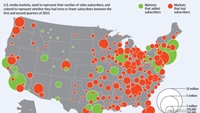Are ‘rabbit ears’ making a DTV comeback?

Regardless of the recent findings by ESPN about the minimal number of cable “cord cutters,” the statistics from several different sources show a growing number of pay-television customers are canceling their subscriptions to local cable companies and finding other sources of programming.
Some, said the “New York Times,” are returning to over-the-air television using traditional rabbit ear antennas.
From April to September, cable and satellite companies had a net loss of about 330,000 customers. Craig Moffett, a longtime cable analyst with Sanford C. Bernstein, told the “Times” that the consensus of the industry executives he had talked to was that most of these so-called cord-cutters were turning to over-the-air TV. “It looks like they’re leaving for the antenna,” he said.
An estimated 90 percent of American households still pay for cable or satellite television. However, America’s relationship with television has recently been in flux, the newspaper said, in part because of the switch last June to digital broadcast signals.
Initially, the switch from analog to digital gave pay-TV providers a group of new subscribers who had worried that their old sets would not pick up the new over-the-air signals. But analysts said some of those subscribers have since gone back to free signals.
That is coupled with the rise of Internet video, which can ease the pain of losing favorite cable channels.
The newspaper cited Bradley Lautenbach, 28, who recently moved to Los Angeles to work at Disney. He found enough alternatives to allow him to turn back the technological clock on his TV.
Get the TV Tech Newsletter
The professional video industry's #1 source for news, trends and product and tech information. Sign up below.
“I’ve always had cable. It’s the thing you do when you move to a new place: call the company and set it up,” he said. Not this time. Instead, he got an antenna and now watches over-the-air news and sports, complemented by episodes of shows like “Entourage” that he buys from iTunes. “I don’t miss cable at all,” he said.
Chris Foster, 29, a graduate student at the University of Virginia, and his wife decided to forgo a $35 fee for basic cable. They watch movies and older shows through Netflix on the Internet and use their antenna for sitcoms and the news.
Forster concedes he misses cable news stations, but overall, he is satisfied. “It feels more like a step forward than a step back,” he said.
Antennas Direct, a maker of TV antennas in St. Louis, expects to sell 500,000 this year, up from 385,000 in 2009, according to its president, Richard Schneider.
Based on customer support calls and feedback from retailers, customers for Antennas Direct are 20-somethings who pair over-the-air and Internet programming, people forced to make choices by a tough economy and others who, he argues, have long been eager to sever ties with their pay-TV provider.
“Over-the-air is the new basic cable,” Schneider said, arguing that free TV and Internet alternatives “are giving people the rationale they’ve been looking for to end a bad relationship.”
Dennis Wharton, the NAB spokesman, said broadcasters believe the trend supports them. Broadcasters, he said, do not mind the move to over-the-air programming because those viewers are also potential audience members for the ads that support programming.
